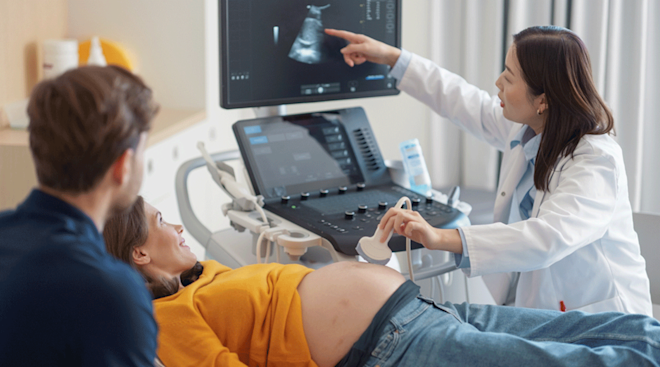What Is the Nuchal Translucency Ultrasound?
You’ll have plenty of tests over the next nine+ months to make sure your pregnancy is progressing well, and the nuchal translucency ultrasound is one you can expect to have in your first trimester. It’s usually combined with other non-invasive prenatal tests (NIPTs) and helps to gauge baby’s chances of having chromosomal and genetic abnormalities. Keep reading to find out from experts what nuchal translucency testing is, how it relates to other NIPTs and how to understand your results.
The nuchal translucency ultrasound (also known as the NT scan or nuchal fold scan) is an optional prenatal test you can get in your first trimester, though it’s recommended by experts in conjunction with non-invasive prenatal testing (NIPT) for more accurate results (more on this below). The nuchal translucency scan looks at and measures the fluid behind baby’s neck and under their skin via ultrasound, explains Rachel Blair Danis, MD, a reproductive endocrinologist and ob-gyn with RMA of New York. Essentially, this measurement is used to assess baby’s chances of having genetic or chromosomal abnormalities, such as trisomy 21 (also known as Down Syndrome and congenital malformations, such as heart defects and skeletal issues.
The nuchal translucency test and NIPTs are both genetic screening tests that are performed during pregnancy, Danis explains—and they’re usually done together as a combined first trimester screening for more accurate results (more on this below). Both types of prenatal tests are time-sensitive during the first trimester, as the nuchal translucency test cannot be done after 13.5 weeks, while NIPT testing cannot be done before 10 weeks, says Christine Greves, MD, an ob-gyn in Orlando, Florida. The combined screening is available between weeks 11 and 13 of pregnancy, according to Johns Hopkins Medicine.
While they’re usually done together, the two tests are not exactly the same. The biggest difference between the two is the method: While nuchal translucency is measured through an ultrasound, NIPT is usually done through blood work. Plus, while related, both tests look for slightly different things. Both NIPT and nuchal translucency tests look for chromosomal abnormalities—such as in chromosomes 21 (Down Syndrome), 13 (Patau syndrome) and 18 (Edwards syndrome), as well as other genetic conditions. But nuchal translucency scans also look for fetal malformations. “The goal [of NIPTs] is to detect fetal fractions of DNA in maternal blood,” Danis says. “[An NIPT] screening test cannot detect fetal physical malformations, like an ultrasound can do in pregnancy.” Plus, while NIPT tests can predict baby’s biological sex with high accuracy, nuchal translucency ultrasounds cannot.
Combined first trimester screening
During a combined first trimester screening, your ob-gyn will do some NIPT blood work and a nuchal translucency ultrasound to get more information that, combined with maternal age, gives a more accurate view of the markers that could indicate baby’s chances of having certain chromosomal abnormalities or genetic conditions. “Together, they’re great screening methods for assessing baby’s well-being very early on,” says Daniel F. Roshan, MD, a maternal fetal specialist at Rosh Maternal & Fetal Medicine in New York City. Plus, the combined screening can also lead to more accurate detection, whereas a standalone nuchal translucency screening can have a higher false positive rate, adds Megan Pallister, MD, an ob-gyn based in Houston, Texas. (In case you’re wondering, for the combined first trimester screening, the false positive rate for a thickened nuchal translucency detecting the risk of Down syndrome is 5 percent, Danis says.)
It’s important to note that nuchal translucency ultrasounds, NIPT and combined first trimester screenings aren’t diagnostic and cannot definitively tell you whether baby will have a chromosomal abnormality; Down, Edwards or Patau syndrome; or another genetic abnormality. Rather, the screening helps provide baby’s estimated chances of developing one of these conditions, based on data and the mother’s age. If the data shows that baby has a 1 in 250 chance—or higher—of having one of these conditions, your doctor may recommend further testing and genetic counseling, Johns Hopkins Medicine notes.
As mentioned above, the nuchal translucency ultrasound usually occurs between 11 and 13 weeks (but ideally between 11 and 12 weeks), Danis says. Like most other ultrasounds during the first trimester, nuchal translucency scans are usually done transvaginally, but they can also be done abdominally depending “on the fetal position and maternal physical build,” Roshan adds. If done abdominally, you’ll feel a cool gel on your abdomen and some light pressure as the clinician moves over it with a probe. If done transvaginally, you may feel some pressure in your pelvic area as the probe is inserted in. “[A transvaginal] ultrasound should not be painful, but tolerable,” Danis says.
You may be able to get a nuchal translucency ultrasound done at your doctor’s office, or you may have to go to a specific center. It’ll be conducted by a trained and certified ultrasound technician, maternal fetal medicine specialist or clinician. Wondering what you need to do to prepare for the nuchal translucency test? It may vary based on your healthcare provider. For transvaginal ultrasound you’ll likely be asked to come with an empty bladder, and for an abdominal ultrasound you’ll be asked to come with a full bladder for optimal visualization. Check in with your ob-gyn on whether there are any preparatory steps you need to take prior to the ultrasound.
One of the most important factors for the nuchal translucency scan is timing. Both Greves and Danis say that pregnant women should not get a nuchal translucency ultrasound past 13 weeks because the results may not be accurate and could result in a false negative or a false positive. Otherwise, there’s really no risk in getting the ultrasound. In fact, the American College of Obstetricians and Gynecologists recommends that all prenatal genetic screening, including the nuchal translucency ultrasound, be offered to all pregnant patients regardless of their age and their risk of chromosomal abnormalities. People undergoing in-vitro fertilization (IVF) and pursuing preimplantation genetic testing (PGT) should also have access to genetic screening and diagnostic testing, Danis says.
While there aren’t really any risks that accompany nuchal translucency testing, some patients may not wish to test. “Some people prefer not to have any testing, and they prefer not to know if they are at an increased risk,” Greves adds. Ultimately, the decision is personal. Each patient should discuss the screening options with their healthcare team and then either pursue or decline the nuchal translucency test based on what’s best for their specific circumstances.
Wondering if the screening is covered by insurance? Generally it is as part of genetic screening, Danis says. However, there may be out-of-pocket costs that could range between $100 to $350 or be higher, depending on your insurance plan and the center’s prices, Roshan notes.
A normal nuchal translucency thickness is about 3 millimeters or less, Danis says, although the exact number can depend on baby’s crown-to-rump length (CRL). An abnormal nuchal translucency is usually when the measurement is above 3 millimeters, and it means baby might be at risk for possible chromosomal or structural abnormalities (like cardiac defects), Roshan says. “There are a range of genetic syndromes that could be associated with increased nuchal translucency.”
Discuss your results with your ob-gyn. If they’re abnormal, your doctor will refer you to a genetic counselor, perinatologist or maternal fetal medicine specialist. They’ll likely also recommend additional genetic diagnostic testing—like amniocentesis, chorionic villus sampling, a second trimester fetal anatomy scan or a fetal echocardiography—to definitively confirm the results, Roshan says.
It can be scary to think about potential issues when it comes to baby’s development. But remember that ultimately the nuchal translucency ultrasound (and many other NIPTs) are not diagnostic—they’re simply a way to gather more information so healthcare providers can do their best to ensure baby’s health and well-being.
Please note: The Bump and the materials and information it contains are not intended to, and do not constitute, medical or other health advice or diagnosis and should not be used as such. You should always consult with a qualified physician or health professional about your specific circumstances.
Plus, more from The Bump:
Daniel F. Roshan, MD, FACOG, FACS, is a board-certified ob-gyn and maternal-fetal medicine specialist with an expertise in high-risk pregnancies. He currently serves as the director at Rosh Maternal & Fetal Medicine in New York City, as well as a clinical assistant professor at NYU Grossman School of Medicine. After earning his medical degree from Tel Aviv University, Roshan received residency training in obstetrics and gynecology at Maimonides Medical Center in Brooklyn and completed a fellowship in maternal-fetal medicine at Johns Hopkins University in Baltimore. He’s an active member of the American College of Obstetricians and Gynecologists (ACOG) and the American College of Surgeons (ACS).
Christine Greves, MD, is an ob-gyn at the Winnie Palmer Hospital for Women & Babies in Orlando, Florida. She received her medical degree from the University of South Florida.
Rachel Blair Danis, MD, is a reproductive endocrinologist and ob-gyn with RMA of New York. She earned her masters degree from the University of Southern California; medical degree from Drexel University College of Medicine; and completed her ob-gyn residency at Hahnemann University Hospital at Drexel University.
Megan Pallister, MD, is an ob-gyn based in Houston, Texas, as well as a Lansinoh clinical advisory network member. She completed her medical degree at the University of Texas Medical Branch School of Medicine and her residency at Baylor College of Medicine.
Johns Hopkins Medicine, First Trimester Screening, Nuchal Translucency and NIPT, 2023
American College of Obstetricians and Gynecologists, NIPT Summary of Recommendations, 2023
Learn how we ensure the accuracy of our content through our editorial and medical review process.
Navigate forward to interact with the calendar and select a date. Press the question mark key to get the keyboard shortcuts for changing dates.





















































